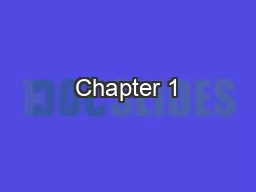/


Financial Statements and Decisions McGrawHillIrwin Copyright 2014 by The McGrawHill Companies Inc All rights reserved The Accounting System The Four Basic Financial Statements BALANCE ID: 412373
Download Presentation The PPT/PDF document "Chapter 1" is the property of its rightful owner. Permission is granted to download and print the materials on this web site for personal, non-commercial use only, and to display it on your personal computer provided you do not modify the materials and that you retain all copyright notices contained in the materials. By downloading content from our website, you accept the terms of this agreement.
Slide1
Chapter 1
Financial Statements and Decisions
McGraw-Hill/Irwin
Copyright © 2014 by The McGraw-Hill Companies, Inc. All rights reserved.Slide2
The Accounting SystemSlide3
The Four Basic Financial Statements
BALANCE
SHEET –
reports the amount of assets, liabilities, and stockholders’ equity of an accounting entity at a point in time.
INCOME
STATEMENT
–
reports the revenues less the expenses
of the accounting period.
STATEMENT
OF
STOCKHOLDERS’ EQUITY
–
reports the changes in each of the company’s stockholders’ equity accounts, including the change in the retained earnings balance caused by net income and dividends during the reporting period.
STATEMENT
OF CASH FLOWS
– reports inflows and outflows of cash during the accounting period in the categories of operating, investing, and financing. Slide4
Balance Sheet
Assets
Cash
Short-Term Investment
Accounts Receivable
Notes Receivable
Inventory (to be sold)
Supplies
Prepaid Expenses
Long-Term Investments
Equipment
BuildingsLandIntangibles
LiabilitiesAccounts PayableAccrued ExpensesNotes PayableTaxes PayableUnearned Revenue Bonds Payable
Stockholders’ EquityCommon StockRetained Earnings
Elements of the Balance SheetSlide5
The Accounting Equation
A = L + SE
Assets
Liabilities
Stockholders
’
Equity
Economic Resources
Sources of Financing for Economic Resources
Liabilities: From Creditors
Stockholders’ Equity: From StockholdersSlide6
Balance Sheet Slide7
Income Statement
Revenues
Sales Revenue
Fee Revenue
Interest Revenue
Rent Revenue
Expenses
Cost of Goods Sold
Wages Expense
Rent Expense
Interest Expense
Depreciation ExpenseAdvertising ExpenseInsurance Expense
Repair ExpenseIncome Tax ExpenseElements of the Income StatementSlide8
Income StatementSlide9
Statement of Stockholders’ equity
Common Stock
Retained Earnings
Elements of the Statement of Stockholders’ Equity
Beginning Retained Earnings
+Net Income
-Dividends
Ending Retained EarningsSlide10
Statement of Stockholders’ equitySlide11
Cash Flows from Operating Activities
Cash Flows from Investing Activities
Cash Flows from Financing Activities
Statement of cash flows
Elements of the Statement of Cash Flows
Note that each of the three cash flow sources can be positive (net cash inflow) or negative (net cash outflow).
+
-
/Slide12
Statement of Cash FlowsSlide13
Currently
, the
Financial Accounting Standards Board
(FASB) is recognized as the body to formulate GAAP.
The SEC has worked closely with the
accounting profession to
work out the detailed rules that have
become known as GAAP.
Generally Accepted Accounting PrinciplesSlide14
To ensure the accuracy of the company’s
financial information, management:
Maintains a system of controls.
Hires external independent auditors.
Forms a committee of the board of directors
to review
these
other two
safeguards.
Ensuring the Accuracy of Financial StatementsSlide15
End of Chapter 1